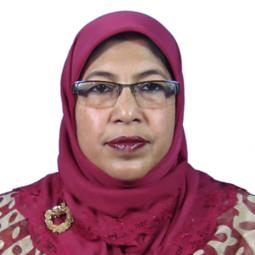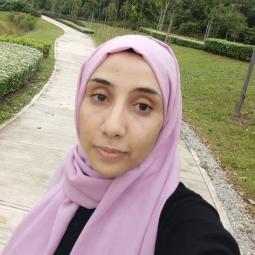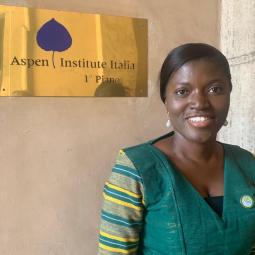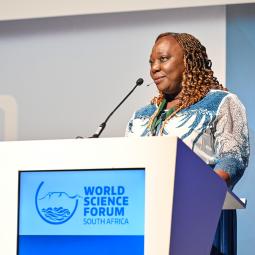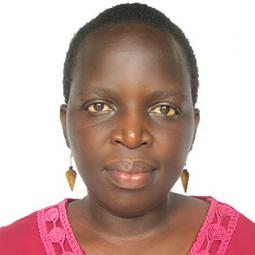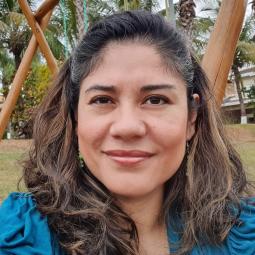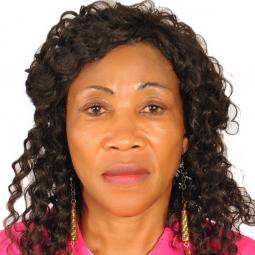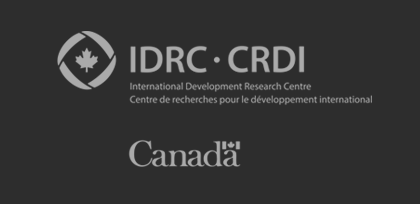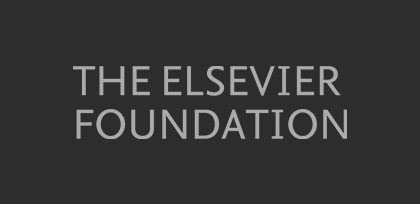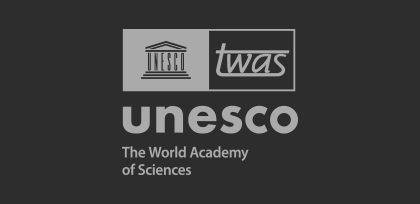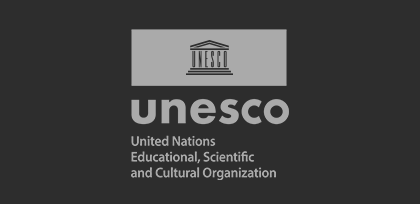OWSD NIgeria National Chapter presents AGRICULTURAL WASTE AS A SUSTAINABLE SOLUTION FOR POLLUTED WATER TREATMENT: EVALUATING HYBRID BIO-ADSORBENTS IN THE NIGER DELTA
May 20, 2025
OWSD Nigeria University of Port Harcourt Branch Series of Scientific Communication: Vivian Igwenagu-Ifeanyi on AGRICULTURAL WASTE AS A SUSTAINABLE SOLUTION FOR POLLUTED WATER TREATMENT
AGRICULTURAL WASTE AS A SUSTAINABLE SOLUTION FOR POLLUTED WATER TREATMENT: EVALUATING HYBRID BIO-ADSORBENTS IN THE NIGER DELTA
BY
Mrs. Vivian Igwenagu-Ifeanyi
Abstract
This study addresses the environmental impact of produced water (PW) in the Niger Delta and proposes a low-cost, sustainable treatment using hybrid activated carbon (HAAC) made from hamburger seed coats and avocado peels. Using 1.5 mol/dm³ ZnCl₂ for activation, the HAAC showed high adsorption capacity (21.40 mg/kg) and significantly improved water quality by reducing turbidity, BOD, COD, and heavy metals outperforming commercial activated carbon. While some values like TDS remained high, most parameters met environmental standards. The study recommends adopting HAAC for PW treatment to support pollution control, local job creation, and sustainable water remediation.
Introduction
The Niger Delta, rich in oil and gas, faces severe water pollution from produced water (PW) a toxic byproduct of oil extraction containing hydrocarbons and heavy metals. This contamination harms both aquatic life and human health. Traditional treatment methods are costly and impractical for large-scale use in the region. Recent research promotes eco-friendly, low-cost alternatives using agricultural waste like hamburger seed coats and avocado peels, which are effective when converted into activated carbon. These bio-adsorbents have shown high pollutant removal efficiency, especially when chemically enhanced. Hybrid bio-adsorbents combining different wastes further improve purification performance, offering a sustainable solution for PW treatment in the Niger Delta. This study aims to assess the effectiveness of hybrid agricultural waste-based bio-adsorbents in treating polluted water in the Niger Delta by:
Evaluating how different optimization conditions affect iodine adsorption capacity of the activated carbon and Comparing the physicochemical properties of produced water treated with developed and commercial activated carbon
Materials and Methods
Sample Collection & Preparation:
Hamburger seeds and avocado pears were sourced from a local market in Obio Akpo, Rivers State. Their seed coats and peels were cleaned, air-dried (7 days), crushed, sieved (1–2 mm), and stored. Produced water (PW) was collected from Obama flow station (Bayelsa) and San Barth (Rivers State); in situ pH and temperature were measured.
Carbonization and Activation
Pre-treated materials were carbonized at 400 °C for 1 hour, cooled, and ground. ZnCl₂ (0.5–2.0 mol/dm³) was used for chemical activation at 60 °C for 20 hrs (1:2 w/v). The mixture was further carbonized at 550 °C for 2.5 hrs, washed with HCl and distilled water to neutral pH, and oven-dried at 110 °C.
Characterization
AOAC and ASTM methods were used to determine carbon yield, ash, moisture, volatile matter, fixed carbon, bulk density, porosity, iodine number, and elemental composition (via SEM-EDX).
Fixed-Bed Adsorption Test
Treated ACs were packed in a column; contaminated PW passed through, and the filtrate was analyzed.
Physicochemical Analysis
Standard methods (APHA, 2005) were used to analyze pH, TSS, TDS, turbidity, EC, BOD, COD, alkalinity, hardness, chloride, nitrate, phosphate, sulphate, and metals (via AAS).
Results
Effect of different optimization conditions on the iodine adsorption capacity of the activated carbon
Iodine adsorption capacity varied with ZnCl₂ concentration, showing a non-linear trend. Capacity was 17.4 mg/g at 0.5 mol/dm³, dropped to 11.9 mg/g at 1.0 mol/dm³, peaked at 21.4 mg/g at 1.5 mol/dm³ (optimal activation), then sharply declined to 7.36 mg/g at 2.0 mol/dm³ due to over-activation and pore collapse.
Table 1: Result of the effect of different optimization conditions on the iodine adsorption capacity of the activated carbon
|
ImpregConc. |
ImpregRatio |
ImpregTempt |
ImpregTime |
CarbonzTempt |
CarbonzTime |
IodAdsortp capacity |
|
A - 0.5 |
1:2 |
600C |
20hrs |
550oC |
2.5hrs |
17.4 |
|
B - 1.0 |
1:2 |
600C |
20hrs |
550oC |
2.5hrs |
11.9 |
|
C - 1.5 |
1:2 |
600C |
20hrs |
550oC |
2.5hrs |
21.4 |
|
D - 2.0 |
1:2 |
600C |
20hrs |
550oC |
2.5hrs |
7.36 |
Figure 1: Chart showing how iodine adsorption capacity varies with different impregnation concentrations
The physicochemical properties of the PW treated withµ activated carbon of study and commercial activated carbon
HAAC from agricultural waste effectively treated Niger Delta produced water, performing comparably to commercial activated carbon (CAC). Both met EGASPIN/DPR standards for pH, temperature, turbidity, COD, BOD, and heavy metals. CAC slightly outperformed in turbidity and solids removal. However, both showed high conductivity and TDS, suggesting further treatment is needed. HAAC excelled in reducing COD, BOD, phosphate, and nitrate, proving a sustainable alternative to CAC.
Table 2: Result of the physicochemical properties of the PW treated withµ activated carbon of study and commercial activated carbon
|
Parameters |
Untreated PW |
Treated PW (HAAC) |
Treated PW (CAC) |
EGASPIN/DPR Standard |
|
pH |
7.20 |
8.00 |
7.70 |
6.5-8.5 |
|
Temperature (°C) |
24.6 |
24.3 |
24.3 |
25 |
|
Electrical Conductivity (µS/cm) |
13786 |
11840 |
12483 |
1400 |
|
Total Dissolved Solids (mg/L) |
6894 |
5922 |
6244 |
5000 |
|
Total Suspended Solids (mg/L) |
564 |
265 |
117 |
50 |
|
Turbidity (NTU) |
78.9 |
12.56 |
2.56 |
30 |
|
Total Hardness (mg/L) |
52.0 |
340 |
164 |
- |
|
Bicarbonate (mg/L) |
36.0 |
824 |
224 |
- |
|
Chemical Oxygen Demand (mg/L) |
128 |
22.8 |
24.6 |
30 |
|
Biological Oxygen Demand (mg/L) |
39.7 |
7.06 |
5.67 |
10 |
|
Nitrite (mg/L) |
<0.001 |
<0.001 |
<0.001 |
- |
|
Sulphate (mg/L) |
34.7 |
7.20 |
4.59 |
200 |
|
Nitrate (mg/L) |
5.30 |
3.97 |
2.65 |
50 |
|
Phosphate (mg/L) |
0.675 |
0.130 |
0.038 |
- |
|
Lead (mg/L) |
3.08 |
<0.012 |
<0.012 |
Unobjectionable |
|
Zinc (mg/L) |
0.31 |
<0.003 |
<0.003 |
5 |
|
Copper (mg/L) |
<0.004 |
<0.004 |
<0.004 |
- |
|
Chromium (mg/L) |
<0.005 |
<0.005 |
<0.005 |
0.5 |
|
Iron (mg/L) |
0.902 |
0.017 |
0.045 |
1 |
|
Mercury (mg/L) |
0.100 |
<0.100 |
<0.001 |
- |
|
Nickel (mg/L) |
0.008 |
<0.008 |
<0.008 |
- |
Figure 2: Bar chart showing the comparison of the physicochemical properties of untreated polluted water (PW) with those treated using Hybrid Activated Carbon (HAAC) and Commercial Activated Carbon (CAC).
Discussion
The study identified 1.5 mol/dm³ as the optimal impregnation concentration for producing efficient activated carbon under fixed conditions (1:2 ratio, 60°C, 20 hrs). This optimized condition significantly enhanced iodine adsorption due to improved pore structure, while higher concentrations reduced performance due to pore collapse. Activated carbon derived from agricultural waste effectively treated produced water, improving clarity, odour, pH, and reducing TDS, though not all values met regulatory standards. The hybrid activated carbon showed comparable or superior performance to commercial variants, supporting its potential for sustainable water treatment in the Niger Delta.
Conclusion
Hybrid bio-adsorbents from agricultural waste, optimized at 1.5 mol/dm³ impregnation concentration, effectively treat polluted water in the Niger Delta. The Hybrid Activated Carbon (HAAC) improved key water quality parameters, performing comparably or better than commercial carbon. Though EC and TDS remained slightly above limits, HAAC shows strong promise as a sustainable, low-cost water purification option.
Recommendation
The study recommends using 1.5 mol/dm³ impregnation concentration for activating bio-adsorbents, as it maximizes efficiency. It also urges authorities to support HAAC adoption in community water treatment to reduce pollution and enhance sustainable waste management in the Niger Delta.






